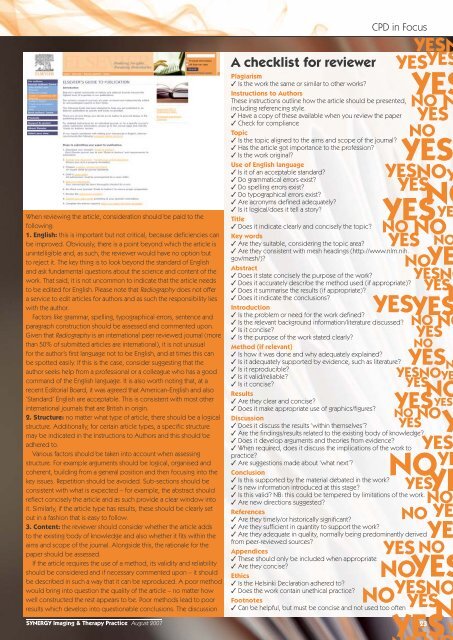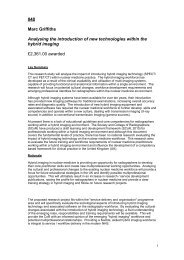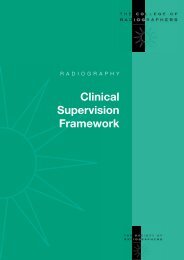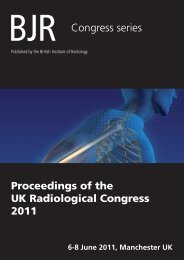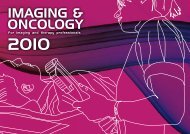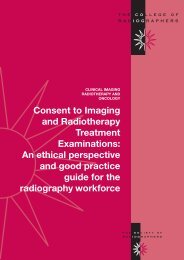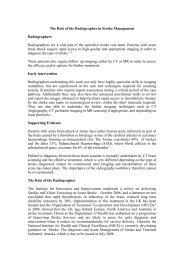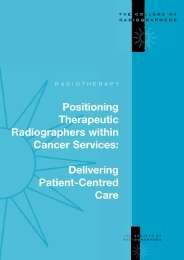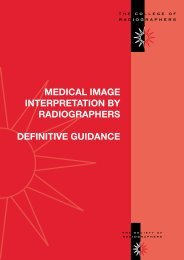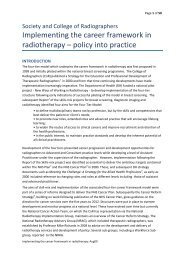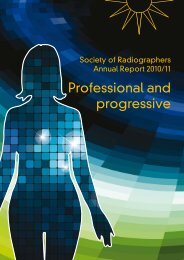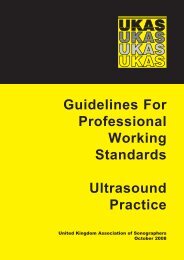Create successful ePaper yourself
Turn your PDF publications into a flip-book with our unique Google optimized e-Paper software.
CPD in Focus<br />
When reviewing the article, consideration should be paid to the<br />
following:<br />
1. English: this is important but not critical, because defi ciencies can<br />
be improved. Obviously, there is a point beyond which the article is<br />
unintelligible and, as such, the reviewer would have no option but<br />
to reject it. The key thing is to look beyond the standard of English<br />
and ask fundamental questions about the science and content of the<br />
work. That said, it is not uncommon to indicate that the article needs<br />
to be edited for English. Please note that Radiography does not offer<br />
a service to edit <strong>articles</strong> for authors and as such the responsibility lies<br />
with the author.<br />
Factors like grammar, spelling, typographical errors, sentence and<br />
paragraph construction should be assessed and commented upon.<br />
Given that Radiography is an international peer reviewed journal (more<br />
than 50% of submitted <strong>articles</strong> are international), it is not unusual<br />
for the author’s fi rst language not to be English, and at times this can<br />
be spotted easily. If this is the case, consider suggesting that the<br />
author seeks help from a professional or a colleague who has a good<br />
command of the English language. It is also worth noting that, at a<br />
recent Editorial Board, it was agreed that American-English and also<br />
‘Standard’ English are acceptable. This is consistent with most other<br />
international journals that are British in origin.<br />
2. Structure: no matter what type of article, there should be a logical<br />
structure. Additionally, for certain article types, a specifi c structure<br />
may be indicated in the Instructions to Authors and this should be<br />
adhered to.<br />
Various factors should be taken into account when assessing<br />
structure. For example arguments should be logical, organised and<br />
coherent, building from a general position and then focusing into the<br />
key issues. Repetition should be avoided. Sub-sections should be<br />
consistent with what is expected – for example, the abstract should<br />
refl ect concisely the article and as such provide a clear window into<br />
it. Similarly, if the article type has results, these should be clearly set<br />
out in a fashion that is easy to follow.<br />
3. Content: the reviewer should consider whether the article adds<br />
to the existing body of knowledge and also whether it fi ts within the<br />
aims and scope of the journal. Alongside this, the rationale for the<br />
paper should be assessed.<br />
If the article requires the use of a method, its validity and reliability<br />
should be considered and if necessary commented upon – it should<br />
be described in such a way that it can be reproduced. A poor method<br />
would bring into question the quality of the article – no matter how<br />
well constructed the rest appears to be. Poor methods lead to poor<br />
results which develop into questionable conclusions. The discussion<br />
A checklist for reviewer<br />
Plagiarism<br />
✓ Is the work the same or similar to other works?<br />
Instructions to Authors<br />
These instructions outline how the article should be presented,<br />
including referencing style.<br />
✓ Have a copy of these available when you review the paper<br />
✓ Check for compliance<br />
Topic<br />
✓ Is the topic aligned to the aims and scope of the journal?<br />
✓ Has the article got importance to the profession?<br />
✓ Is the work original?<br />
Use of English language<br />
✓ Is it of an acceptable standard?<br />
✓ Do grammatical errors exist?<br />
✓ Do spelling errors exist?<br />
✓ Do typographical errors exist?<br />
✓ Are acronyms defi ned adequately?<br />
✓ Is it logical/does it tell a story?<br />
Title<br />
✓ Does it indicate clearly and concisely the topic?<br />
Key words<br />
✓ Are they suitable, considering the topic area?<br />
✓ Are they consistent with mesh headings (http://www.nlm.nih.<br />
gov/mesh/)?<br />
Abstract<br />
✓ Does it state concisely the purpose of the work?<br />
✓ Does it accurately describe the method used (if appropriate)?<br />
✓ Does it summarise the results (if appropriate)?<br />
✓ Does it indicate the conclusions?<br />
Introduction<br />
✓ Is the problem or need for the work defi ned?<br />
✓ Is the relevant background information/literature discussed?<br />
✓ Is it concise?<br />
✓ Is the purpose of the work stated clearly?<br />
Method (if relevant)<br />
✓ Is how it was done and why adequately explained?<br />
✓ Is it adequately supported by evidence, such as literature?<br />
✓ Is it reproducible?<br />
✓ Is it valid/reliable?<br />
✓ Is it concise?<br />
Results<br />
✓ Are they clear and concise?<br />
✓ Does it make appropriate use of graphics/fi gures?<br />
Discussion<br />
✓ Does it discuss the results ‘within themselves’?<br />
✓ Are the fi ndings/results related to the existing body of knowledge?<br />
✓ Does it develop arguments and theories from evidence?<br />
✓ When required, does it discuss the implications of the work to<br />
practice?<br />
✓ Are suggestions made about ‘what next’?<br />
Conclusion<br />
✓ Is this supported by the material debated in the work?<br />
✓ Is new information introduced at this stage?<br />
✓ Is this valid? NB: this could be tempered by limitations of the work.<br />
✓ Are new directions suggested?<br />
References<br />
✓ Are they timely/or historically signifi cant?<br />
✓ Are they suffi cient in quantity to support the work?<br />
✓ Are they adequate in quality, normally being predominantly derived<br />
from peer-reviewed sources?<br />
Appendices<br />
✓ These should only be included when appropriate<br />
✓ Are they concise?<br />
Ethics<br />
✓ Is the Helsinki Declaration adhered to?<br />
✓ Does the work contain unethical practice?<br />
Footnotes<br />
✓ Can be helpful, but must be concise and not used too often<br />
SYNERGY Imaging & Therapy Practice August 2007<br />
23


